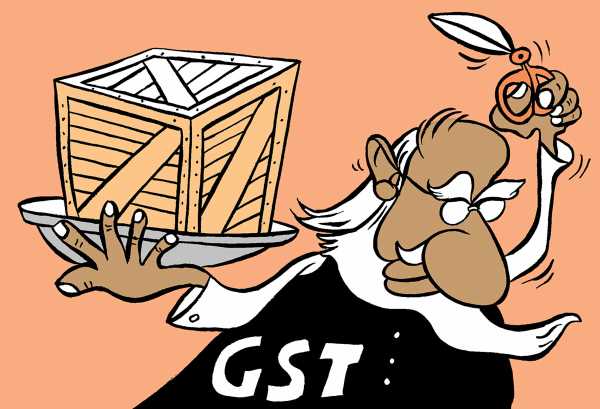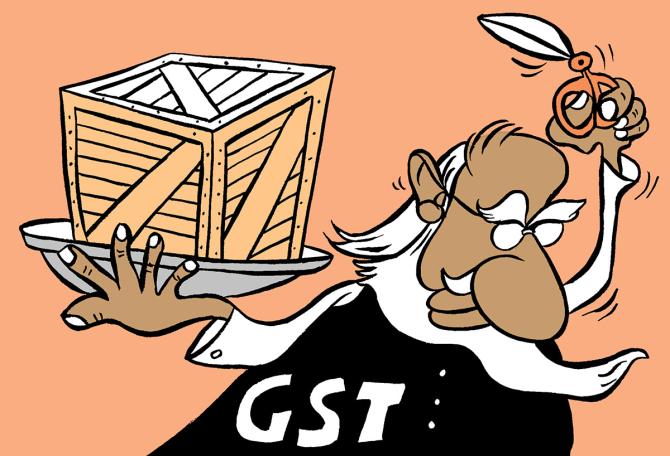How Long Will GST Growth Continue?
It is now becoming increasingly clear that rising imports have played a significant role in sustaining the buoyancy in revenues from GST, notes A K Bhattacharya.
Tax collections data for the first half of the current financial year have just been released.
The numbers indicating growth in collections look impressive.
Direct taxes, consisting primarily of corporation and personal income taxes, have grown by 24 per cent, while the goods and services tax, or GST, have shown an increase of 31 per cent.
The data for excise and Customs are available only for the first five months and both indicate a decline of 17 per cent and 14 per cent, respectively.
The trends that emerge from these numbers, however, tell you a more nuanced story about tax collections.
From the point of view of the Union Budget and the need to stay below the fiscal deficit target of 6.4 per cent of gross domestic product, or GDP, these tax collection numbers certainly augur well for the state of public finances.
Gross tax revenues in 2022-2023 were expected to grow by less than 2 per cent and the 19 per cent increase recorded in the first five months is way above that target.
Of course, the government has to carry the burden of both a revenue shortfall on account of a reduction in excise duty on petroleum products and of extra expenditure, not provided for in the Budget, like the extension of the free food ration scheme and an increase in fertiliser subsidies. But there are also savings on account of lower food procurement and unused funds allocated to a few central ministries.
On the whole, the government is justifiably confident of meeting its fiscal deficit target for the year and has indeed planned for a lower borrowing during the second half of 2022-2023.
But higher tax collections should also be judged by how well the revenues have grown in relation to the expansion in the nominal size of the economy.
There is no official data on the size of the Indian economy in the first half of 2022-2023. But comparing tax collections with the size of the economy in the first quarter, for which period the GDP number is available, tells a slightly different story.
During April-June 2022, the Centre’s gross tax revenues rose by 22 per cent to Rs 6.5 trillion, but the tax-to-GDP ratio had fallen.
The share of tax revenues in GDP had declined from 10.35 per cent in April-June 2021 to 10 per cent in the same period of 2022.
The government had projected the share of gross tax receipts in GDP at 10.7 per cent in 2022-2023 and the first quarter’s performance was not encouraging.
Note that the gross tax revenue growth has already begun to slow down.
It was 22 per cent in the first quarter of 2022-2023 and in the first five months, it was down to 19 per cent.
Even direct taxes growth has slowed down in this period — from 35 per cent in the first quarter to 29 per cent recorded in the first five months of the current financial year.
Take another yardstick — advance tax collections, which are an indication of what taxpayers anticipate their earnings and tax liability to be in the coming months.
Advance tax collections by June 15 grew by 33 per cent, but by the end of September 15, the growth was only about 12 per cent.
The second quarter advance tax collection figures clearly indicate a none-too-encouraging situation with regard to economic growth.
The decline in excise collections is understandable as the government had cut excise duty on fuel products to rein in their retail prices.
This led to a decline of 17 per cent in April-August 2022, which was higher than the 14 per cent drop that had been projected in the Budget for 2022-23. And this gap may widen a bit over the next few months, given the current trend of international crude oil prices and the government’s desire to keep inflation under check.
What about GST revenues? Total GST collections in the first half of 2022-2023 have grown by 31 per cent, even though the month-on-month revenues growth has remained virtually flat after May.
The big question is, for how long will this growth in GST collections be maintained?
To be sure, the share of GST collections in the April-June quarter of 2022 in GDP was 6.97 per cent, higher than the 6.5 per cent in the same quarter of 2021 and 6.24 per cent in the January-March quarter of 2022.
But it is important to recognise that this growth is aided significantly by imports.
Even as total GST in April-September 2022 grew by 31 per cent, the component of integrated GST or IGST levied on imports increased by 44 per cent.
In other words, the share of IGST on imports in total GST rose to 27 per cent.
This share was 25 per cent in the whole of 2021-2022 and even lower at 22 per cent in 2019-2020.
It is now becoming increasingly clear that rising imports have played a significant role in sustaining the buoyancy in revenues from GST.
This takes one to the perceived notion of declining Customs revenue.
It may be a puzzle to many that even as India’s merchandise imports are rising at a steady pace (they grew by 38 per cent in April-September 2022), the Customs collections have fallen. But the fact is with a rising share of IGST on imports in total GST, the total collection of taxes on imports has been on a steady rise.
Customs revenue rose from Rs 1.09 trillion in the pre-Covid year of 2019-2020 to Rs 1.99 trillion in 2021-2022, just as IGST on imports rose from Rs 2.66 trillion to Rs 3.75 trillion in the same period.
It is true that Customs revenue in the first five months of 2022-2023 fell by 14 per cent, but taken together with IGST on imports, the government’s total tax revenue from imports in this period has gone up by 24 per cent.
A depreciating rupee and higher commodity prices may have contributed to this. But those who look at only India’s Customs revenue and conclude that India still has a relatively low import duty collection rate (total imports divided by revenue collected) should think again.
Feature Presentation: Rajesh Alva/Rediff.com
Source: Read Full Article


